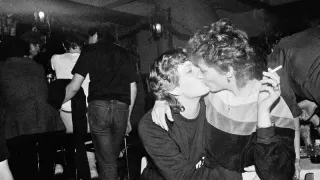November 15, 2022
Bernice Bing: Asian Art Museum's showcase of the rediscovered artist
Robert Brokl READ TIME: 8 MIN.
The powerful exhibition of work by San Francisco artist Bernice Bing recently opened at the Asian Art Museum, with its run extended through June. There's ample reason for the revival of interest in Bing's work and life, nearly a quarter century after her death in 1998.
The Museum acquired 24 of the works on view for their permanent collection, part of a new emphasis upon "under-recognized modern and contemporary Asian American artists."
Bing (Bingo to her friends) identified her obstacles as being a woman, Asian, and lesbian. The narrative that identifies Bing as a bridge between cultures and identities doesn't do justice to her evolution and search, nor to her as yet unfixed place in Bay Area art history.
Other local Asian-American artists like Ruth Asawa and Hung Liu have established national reputations, but Bing was saddled with a difficult childhood. Born in San Francisco's Chinatown in 1936 to a Chinese immigrant father and an American-born Chinese mother, with the Chinese Exclusion Act still on the books, Bing's mother and aunt broke with tradition, working in the Forbidden City nightclub in San Francisco, her mother as a "hot girl" dancer and waitress.
But her mother died of a heart attack when Bing was five, and her father died in prison about the same time. Bing and her sister were placed in Caucasian foster homes, even though her aunt and grandmother were still alive.
Art Rebel
The young Bing was described as rebellious, but her grandmother's encouragement of her drawing ability gave her a direction. After graduating from Oakland Technical High School, Bing won a scholarship to attend California College of the Arts (and Crafts), where she studied with mentors and influences like Richard Diebenkorn, Nathan Olivera and, significantly, Saburo Hasegawa, who exposed her to Asian art, Chinese philosophers, Zen Buddhism, and calligraphy.
After a semester, she transferred to the California School of Fine Arts (renamed San Francisco Art Institute). She got her MFA in 1961, and fellow graduates and friends included luminaries-to-be like Joan Brown, Leo Valledor, William Wiley, Robert Hudson, and Cornelia Schulz.
Her visibility continued with participation in the "Gangbangers" show at the almost mythical Batman Gallery, one of four women, including Jean Conner and Brown. Batman was established by poet Michael McClure and artist Bruce Conner, who painted the walls, floor, and ceiling black.
Bing had a follow-up solo show the same year, with large expressionist paintings showing early promise and verve, reflecting the influences of Diebenklorn, deKooning, and Gorky. "A Lady and a Road Map," an oil painting from 1962, is the standout from this period. Loose, exuberant, painterly brushwork, color choices referencing both the figure and nature, including the bright pinks in the sketchy female figure reminiscent of deKooning's famous "Women" series.
Bing had a close friendship with Brown in particular. Brown titled a 1960 painting of her pitbull "Portrait of Bob for Bingo," and she accompanied Brown to her Staempfli Gallery show in New York the same year. Some of Bing's paint-handling from this period is similar to Brown's impasto technique.
Beats and Batman
Natasha Boas, writing in Square Cylinder in Oct. 16, 2019, notes the "...art world marginalization that came from being an Asian-American lesbian artist coming up in the avant-garde world of the SF Beat artists in North Beach, a milieu dominated by hetero-normative-couple culture and the white male artists who were her classmates at SFAI. Jean and Bruce Conner, Manuel Neri and Joan Brown, Wally Hedrick and Jay DeFeo were some of the twosomes living and working in the building at 2222 Fillmore (also home to Batman Gallery) that became known as Painterland."
The 2013 documentary "The Worlds of Bernice Bing," produced and directed by Madeline Lim, reports that Bing had another life going, too: A "wild butch, smoking Shermans, and drinking brandy" in lesbian bars. She lived in her studio above the Old Spaghetti Factory in North Beach, where she also waitressed.
But she soon made the life – and career-changing – decision to move to the Mayacamas Vineyard, in Western Sonoma, to live and work for three years. There, her work turned even more to landscape-influenced imagery. She returned for a Berkeley Gallery show. Her self-imposed retreat from the thriving cultural scene in San Francisco invites comparison with an alternative path taken by Joan Brown, whose retrospective just opened at SFMOMA.
Like Bing, a child with an unhappy childhood who pursued a spiritual path as an adult, Brown thrived in the male-dominated art world, scoring representation complete with stipend fresh out of school with the Staempfli Gallery, and securing a tenured teaching position at UC-Berkeley. Her estate is now represented by the blue-chip Matthew Marks Gallery in New York.
Career Shift
With Bing's isolation at Mayacamas came other setbacks: A group of paintings, including "Elements," were stolen. In 1967, Bing sold enough of her artwork to pay for a stay at the Esalen Institute in Big Sur as their first resident artist, pursuing her interest in New Age philosophy and the teachings of Carl Jung.
Back in San Francisco, Bing became an activist and arts administrator. She served as director of the South of Market Cultural Center (now SOMArts) from 1980 to 1984. Experiencing burnout and needing to recharge, Bing won a Fulbright grant to go to China in 1984-85. As a Chinese woman raised in Western society and culture, including Western art techniques like oil painting, she developed through her studies in China a greater appreciation for Eastern art forms like calligraphy, while deepening her connection to Buddhism.
She wrote: "Chinese calligraphy has been evolving for six thousand years, whereas in our Western society we are but primitives experiencing a new aesthetic. I am attempting to create a new synthesis with a very old world."
Upon her return, Bing once again chose a more pastoral retreat, this time in the hamlet of Philo in Mendocino County, living in a barn studio, tending goats, and working as a cook. The important large (12'X8') early painting"Dipytch" was ruined by damp.
But she also met the Mills College art professor Moira Roth, who championed her work. Through Roth, she became a founding member of the Asian American Artists Association (AAWAA).
Her major last series, on view at AAM, are the watercolor and mixed media paintings on paper on the lotus theme, based upon calligraphy. They display a mastery of control and spontaneity. Her apotheosis is probably "Epilogue," from 1990-95. A long (6' X 24'), horizontal oil on canvas work, the piece includes her early, abstracted figures and later calligraphic flourishes in gestural brush work, with a predominance of sunny yellow, bisected top to bottom by a dark vertical; a metaphor for her life?
Legacy
By the mid-1980s, Bing's invisibility and marginalization was evidenced by her bare appendix mention in critic Thomas Albright's canonical tome, "Art in the San Francisco Bay Area, 1945-1980," which showcased her contemporaries like Brown, Wiley, DeFeo, and Hudson. She remained in touch with some of them, attending Jay DeFeo's 60th, and last, birthday party at her Oakland loft, along with Brown and Neri.
Bing died age 62 in 1998, of lupus, hemochromatosis (a dangerous build-up of iron in the blood), and cancer.
But Legacy Land has a way of refreshing reputations, churning the past in unexpected ways. Enter "Team Bingo" (self-described), a determined cohort of mostly Asian-American women artists, art professors, writers, and art professionals, mostly lesbians, who dedicated themselves to documenting, preserving, promoting, and placing Bing's artwork and papers.
Lenore Chinn, Elisabeth Cornu (long affiliated with San Francisco's GLBT Historical Society), Kim Anno, Flo Oy Wong, Alexa Young, and Frieda Weinstein are just some of this group, and Rudy Lemcke developed the Queer Cultural Center's website's featuring Bing.
Bing's revival was sparked by the 2019 solo Sonoma Valley Museum of Art exhibit, with catalog, some thirty years after her memorial solo show at the SOMAR Gallery in 1991. Recently, the Fine Arts Museums of San Francisco acquired "Mayacamas IV, Bismarck Saddle," from 1963.
The former art critic for the SF Chronicle, Charles Desmarais, wrote a rather sour 'What if?' review of Bing's Sonoma show, suggesting her career and work were stunted by too few resources, distractions like work and community participation, rural isolation, etc., but I would disagree. While many artists have built reputations upon creating a brand and endless repetition of work proven commercial, artists like Bernice Bing, who stubbornly and intuitively follow their own paths, however lonely or difficult, finding their own truths, are the nobler ones.
'Into View: Bernice Bing, through June 26, 2023, at the Asian Art Museum, 200 Larkin St. www.asianart.org
Help keep the Bay Area Reporter going in these tough times. To support local, independent, LGBTQ journalism, consider becoming a BAR member.






